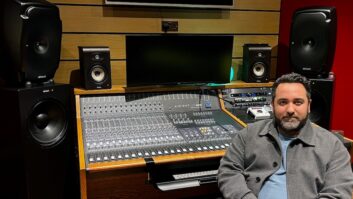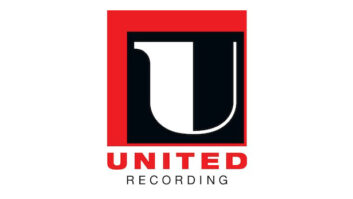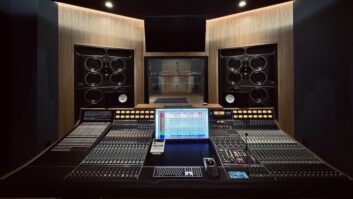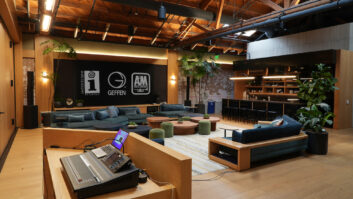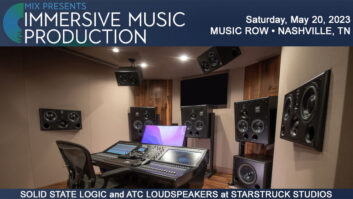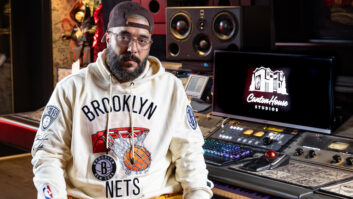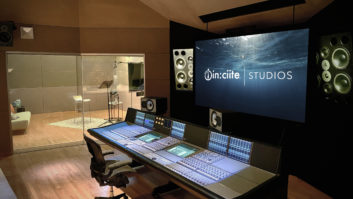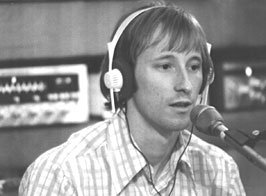
Life is full of coincidences. It just so happens that 1977 was also the year that Jay Gallagher and George Hallowell founded Ultrasonic Studios in New Orleans. It also just so happens that the day we interviewed Gallagher and Hallowell about the early days of Ultrasonic was the second anniversary of the day Hurricane Katrina hit, swallowing the studio along with much of the city.
Young Jay Gallagher engineering a session, circa ’77
What were you guys doing before you started the studio?
Gallagher: We were in college before that. We were just kids. We built Ultrasonic ourselves, physically. It took nine months to build it, starting in ‘76 so we opened in ‘77.
How did you decide to start a studio?
Gallagher: I had been recording people in college on a little 4-track system, and they started paying me in things they made, like wallets and things. We were both out of school and working in stereo stores, and I said, “Why don’t we build a studio? We might make some money?” So we made a go of it. We started out small, 16-track, and every time we got the money, we’d expand.
Tell me about the building and location.
Gallagher: Once we decided that New Orleans was the place rather than Houston, which was a good idea — there were more musicians and less competition — we looked for three months and picked out 10 buildings that we thought were appropriate. We rated them each on a scale of one to 10, and the one we gave the highest rating was a 4,300-square-foot building — a tin-roof building; there’s a mistake — on Washington Avenue, right across the street from Xavier University. It was a good location because it was close to the freeway, in what they call Mid-City, so it was easy to get to from all places. The roof was a problem in the early years. We eventually fixed that with acoustics, but that took awhile and money.
Other than the roof, all the renovations we did over the years were to make more paying space. In the end, we had a big A room, a B room we used for digital editing and voice-over work and some mastering, and we had offices, a green room, a kitchen and a machine room, all in the same building that went under in Katrina, and that’s what ultimately killed Ultrasonic. The building got sold last year, and the new owners took a bulldozer to it from front to back.
What gear did you have when you first opened?
Gallagher: When we opened, we decided to go with new MCI gear. They were sort of the up-and-coming, mass-market consoles and machines. We ended up buying a JH16 tape recorder and a 428 console, which was only fitted with 16 inputs at the time. It was a small console, but it allowed us to learn the craft and we made some fine recordings. We bought them from Audio Consultants in Nashville, and then we upgraded the console in 1986 or so to an automated 52-input MCI 652.
Who were some of your early clients?
Hallowell: We did a lot of R&B and Dixieland. Not necessarily anyone you would have heard of, but a lot of great players. Eventually, most everyone who ever recorded in New Orleans was in there at some point. Some notables were Aaron Neville, Linda Ronstadt, k.d. lang, Dave Stewart, Dr. John and Dolly Parton.
Who would have been your competition back then?
Gallagher: Allen Toussaint and Marshall Sehorn had their studio called Sea Saint [New Orleans’ first state-of-the-art studio, built in 1973], and there was a very good Westlake facility called Studio in the Country that was built in 1973; that was in Bogalusa out in the woods, and that was run by Bill Evans at the time.

Ultrasonic in the early days
How long did you continue doing all the engineering at Ultrasonic?
Gallagher: George stayed six or seven years [before leaving to pursue studio architecture and acoustics], and I continued engineering, but a few years after George left I started hiring engineers. I hired Scott Goudeau, who was a great guitar player/engineer. Later I hired David Farrell from a competing studio, and that’s when things really got going. Blacktop and Rounder were the two big clients in New Orleans, and they went with David, basically, so we got those two. Blacktop was local to New Orleans and Rounder was from Boston, and they both did a lot of indigenous music and R&B.
Steve Reynolds was also a great addition. He was fresh out of Full Sail but had been a professional musician prior to that. They took over all the engineering chores, and I got into advertising sound — first at the studio in one of our other rooms, and then I started a facility downtown, which later became the Swelltone film mix room where I linked up with [film sound editor/re-recording mixer, and Mix sound-for-picture editor] Larry Blake. In 1990 I started doing advertising full time, and then about 1999 I switched over to film full time. In 2002, we sold the studio to Dave and Steve. I kept the building, but they kept the business. But when Katrina hit, they got wiped out.
Now, Steve is teaching at NOCCA, which is a prestigious creative arts high school in New Orleans, and Dave is doing engineering work at various studios around town. He’s keeping busy, but he doesn’t have a home base anymore.
They did salvage some of the equipment from Ultrasonic. By that time, they were Pro Tools-based, so that was a lot easier to move around than the 24-track was.
Hallowell: They have a nice 24-track Studer that’s now a doorstop.
What was cool about having a recording studio in New Orleans in 1977?
Hallowell: It was a real learning experience and a lot of fun for us because we didn’t know anything about studios, we didn’t know anything about construction, we didn’t know anything about business, and we had to sort of learn it all at the same time that I think New Orleans was coming of age, too, in terms of the studio business. There’s always been a lot of live music and music history in New Orleans, but it all seemed to be coming together around the time we decided to open the studio. It was a really fun time. It was a little nerve-wracking at times, though, because we didn’t really know what we were doing.
Gallagher: We really didn’t!
What’s next for each of you?
Gallagher: We’ve moved to North Carolina and formed a new company in Raleigh called Theater Design Labs. It’s going to be a high-end home theater design firm.
In California, we get all our information about the post-Katrina recovery from the news. How do things look to you?
Gallagher: The sections that did not get wet are fine: the French Quarter, downtown, right along the river. But where things did get wet, things are not fine, and that’s about 60 percent of the city, the places where people live.
Hallowell: It’s hard to realize how much infrastructure is gone until you’re there. It’s not like someone can just buy a house cheap now and move in.
Gallagher: There are a lot of important things that are missing or seriously wounded.
Hallowell: The people of New Orleans have so much history and so much fortitude that I think it will come back, it’s just going to take awhile.
Barbara Schultz edits Mix’s monthly “Coast to Coast” section.

